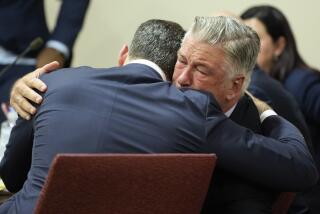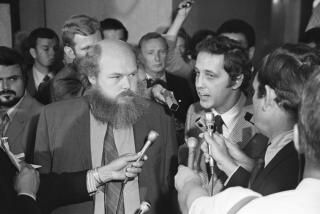Lunch and Murder Trial Drag On : Wheels of justice turn slowly when judge spends more time on breaks than on the bench for a double murder case. Lawyer fees, meanwhile, drive up costs.
The case was a double murder, gang-related and gory--standard fare these days at the Criminal Courts Building in downtown Los Angeles. Deputy Dist. Atty. Ralph Shapiro estimated it would take five months to seat a jury and try the case.
What Shapiro did not factor in was the work habits of Superior Court Judge Clarence (Red) Stromwall, a retired police detective who sports military-like service stripes on the sleeve of his black robe.
“This was the longest and slowest trial I’ve ever been in,” Shapiro said. “It is something I never, ever want to do again.”
Stromwall, The Times found, spent more time at lunch each day than he did trying the case.
The trial also was prolonged because the judge handled hundreds of other criminal matters in the interim and because of vacations for Stromwall, attorneys and jurors.
Jury selection began in April, 1989, and more than 1 1/2 years later, the case still is not over. The cost to taxpayers has been more than $750,000 for court-appointed defense attorneys alone.
Although an extreme example, the case illustrates how delays can hinder the delivery of justice in Los Angeles and further burden a system already choking on crime.
On trial before Stromwall were three gang members accused of robbing and shooting to death two men in South-Central Los Angeles in November, 1984. The suspects had been arrested in 1985 but, because of repeated delays, the case took four years to reach Stromwall’s courtroom.
Before taking testimony each morning, Stromwall, like most judges, would first “clear the calendar” by handling other criminal cases assigned to his court.
Records show that he then would begin proceedings in the murder trial on average at 11:34 a.m. and break for lunch at 12:02 p.m. Afternoon sessions began on average at 2:25 p.m. and ended about 4 p.m.--with a 20- to 30-minute break in between.
In all, the trial was in session about 1 1/2 hours each day, records show.
Lunch recess, meanwhile, ran an average of 2 hours and 23 minutes.
Stromwall, appointed in 1984 by Gov. George Deukmejian, said he spends “normally an hour and a half” at lunch. “I brown-bag it frequently,” Stromwall said.
The Times followed Stromwall twice at lunch time. Both days, shortly after noon, the judge drove alone to the Saratoga restaurant and lounge on Sunset Boulevard.
He did not eat lunch there. Stromwall sat at the bar, sipping bourbon over ice for more than 1 1/2 hours each day--three drinks on Sept. 25 and four on Oct. 17. He was back on the bench by 2:30 p.m. on both days.
“That’s very possible,” Stromwall said when asked about his trips to the Saratoga.
His boss, supervising criminal Judge David A. Horowitz, had no comment when asked about Stromwall’s lunchtime activities. “He does his work,” Horowitz said.
Stromwall pointed out that in the time it has taken to try the double-murder, he has handled more than 1,000 other cases, including half a dozen other jury trials.
Like many other Superior Court judges in Los Angeles, Stromwall does not schedule trial on Fridays, leaving him free to hear various motions and do paper work in chambers. Last year, he stopped scheduling trial in the case on Thursdays, too.
In June, 1990, after 60 weeks, including juror selection, the double-murder case went to the jury. Deliberations were delayed a month while some jurors took previously scheduled vacations.
Verdicts were announced in August. The jury deadlocked on the fate of Michael (Rat Capone) McKinley while Kevin (T-bone) Johnson was convicted and sentenced to 52 years to life in prison.
The third defendant and the only one facing the death penalty, Marvin (Big Blue) Williams, also was convicted but has yet to be sentenced. Jurors deadlocked in late November after a special “penalty phase” required in all capital cases.
Prosecutor Shapiro said he has not yet decided whether to retry McKinley but fully intends to retry the penalty phase against Williams, a process that will require a new jury and very likely will take several more months.
While the case remains a morass for Shapiro, who earns $85,000 a year, it also has been time consuming for the four court-appointed defense attorneys, as evidenced by their billings.
The four, along with their investigators, were paid $778,909 through June, according to the most current records available. The largest payments were made to attorneys Dennis E. Mulcahy, who received $270,550, and Donald J. Calabria, who got $224,975. Each lawyer was paid $100 an hour for trial time and $90 an hour for research and preparation.
Under the payment system, court-appointed attorneys submit vouchers to trial judges, who review and forward the bills to the county. Last year, more than $50 million was paid out.
The Times compared randomly selected, day-by-day billings for each attorney in the double murder case and found they consistently billed for more hours than the trial was in session.
Mulcahy often billed five hours a day for trial, records show, even on days when trial lasted less than 30 minutes.
On May 22, official transcripts indicate that trial began at 11:45 a.m. and ended 13 minutes later because a juror was ill. On that day, Mulcahy billed the county five hours for trial and six hours for preparation, amounting to $1,040, records show. Calabria billed one hour for trial and eight hours for preparation, a total of $820.
“I don’t know why exactly I billed those hours,” Mulcahy said. “If I billed time on the case, I put time in on the case.”
He pointed out that his client, McKinley, was the only one of the three defendants not convicted.
Both Mulcahy and Calabria commended Stromwall as a fair and hard-working judge.
“His court may be a little slower than others,” Calabria said, “but this man has done tremendous, tremendous good for so many people.”
More to Read
Sign up for Essential California
The most important California stories and recommendations in your inbox every morning.
You may occasionally receive promotional content from the Los Angeles Times.










